Xcel & GRE bring CapX2020 to PUC
September 22nd, 2006
CapX2020 moving right along… Here’s the map that wouldn’t load yesterday:
(guess not…)
Technically, it’s Xcel and Great River Energy bringing us this line (GRE’s one of those who also brought us Big Stone)(and then there’s Big Stone Wind, but that’s for another day…), but we know this big web of transmission lines across the state wouldn’t be possible without the acquiescence of those who signed the June 2003 TRANSLink deal and paved the way for the 2005 Transmission Omnibus Bill from Hell. The horse is out of the barn, though we can clearly see the horses’ asses.
OK, look above at that horizontal blue line across the state, just south of the cities? Then it goes down and east? That’s the “Brookings” to “Hampton Corners” (Prairie Island) and then “SE Metro” to LaCrosse” which is really on big export line from SW Minnesota (Big Stone II) to Wisconsin. At the MAPP meetings I go to sometimes (when it’s interesting stuff, they always schedule way far away), this has always been the SW to PI and PI-Roch-Lax, and suddenly it changed to “Hampton Corners” and in the Notice Plan handouts, they tried to present it as two separate lines. Right…
Here’s the maps as they present them now: MAPS
Here’s the map that drives me crazy, the logical link between Hampton Corners and Prairie Island is missing.
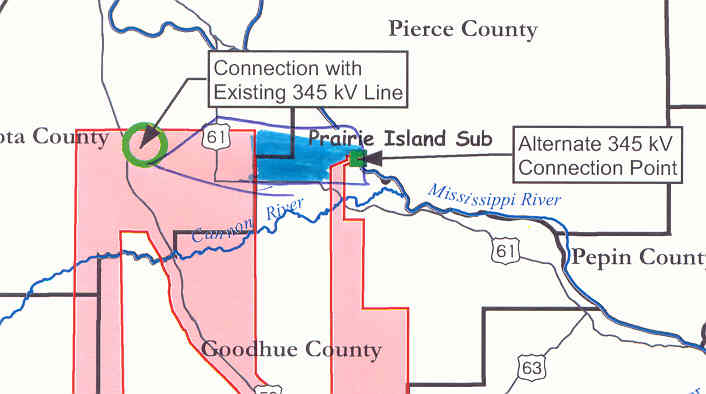
Notice that at the green circle on the Left, it says “Connection with Existing 345kkV line.” OK, so you connect with that line, then what? Well, look at that map above, it goes out to Wisconsin. How do you get to WI from there? You either go southeast, along that new corridor shown on the map along 52, where there is no line, no easements, and which is contrary to Minnesota’s non-proliferation theory where you have to use existing corridors… OR you do the logical link, where at Hampton Corners, they’re connecting with the existing line, well DUH, as they’d said in all prior iterations, it’s a line that connects to PI, so you run along that pre-existing corridor, as requred under the PEER decision, over to Prairie Island. BUT THEY LEFT THAT PART OFF THE MAP, AND LEFT THOSE FOLKS ALONG THAT CORRIDOR OUT OF THE NOTICE PLAN, LEFT THEM OUT OF THE LOOP!!!! So I had a few go-rounds with Koppendrayer, he was very invested in keeping it separate. BUT, thankfully I’d put that map above in my Comment so they could look at it and see the big plan. Nickolai got it and acknowledged it and made the Motion to amend to include that corridor between Hamption and Prairie Island along the existing 345kV corridor.
You know, this isn’t rocket science, it’s just connect the dots. Commerce’s Steve Rakow may think being able to connect the dots is “conspiracy theory,” so he says, but I’d rather be able to track trajectory than live in delusion land. And what does he know — he’s the one who said that the line went through “Red Wing Township” and “Winona Township” and sure didn’t want to hear otherwise. OK, fine, put that in writing! See fn 5 and my Comments on p. 5-6 in the Staff Briefing Papers. Even Xcel agreed it’s CITY OF Red Wing and Winona.
All in all, not a bad time. Got acknowledgement that “it’s all connected.”
And it was very obvious that many parties were missing at the table yesterday — those who did the TRANSLink deal, those who ushered the 2005 Transmission Bill from Hell through the legislature, those who made this CapX2020 nightmare possible. Thanks guys… this legacy, 50+ years of infrastructure commitment down the wrong road, will far outlast you.
Now, how to stop this bulk-power-transfer nightmare? There’s a little time before the application is filed.
That means it’s a good time to read Powerline again for some inspiration and focus… If you don’t have it, there’s usually a couple at www.abebooks.com.
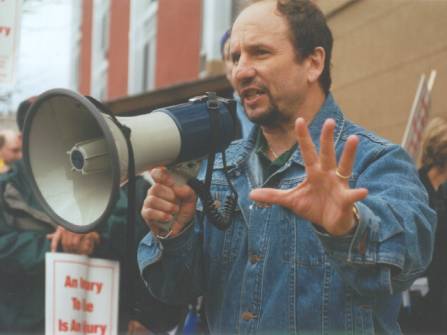
Excerpt from POWERLINE: THE FIRST BATTLE OF AMERICA’S ENERGY WAR
________________
Foreword by Senator Tom Harkin
A local rebellion occurred in several rural countries of west central Minnesota in the mid- to late 1970s over the decision to locate an electric powerline through good farmland there. The campaign of opposition by farmers and their supporters is now an established chapter in state history. Lore about the “bolt weevils” who toppled giant steel transmission towers at night has been passed on as a compelling image of rural people’s resistance against power companies and state authorities. The events of the powerline struggle amount to a noteworthy episode of populist protest, and this book remains that story’s most thorough telling.
The fact is, though, that today we probably read this book mostly because we know that one of the story’s tellers, an activist college professor a the time, Paul Wellstone, eventually became a U.S. senatorâ??a senator who would make unique and dramatic contributions to our country’s history an dpolitical life in his far-too-brief career. After cowriting this book, Paul went on to participate in, teach about, and write on other Minnesota and national political struggles throughout the 1980s. Then, in 1990, he was elected to the U.S. Senate. He promptly carried the kind of fight and values described in the book straight to Washington, where he shook things up for twelve years and rocked the system right up until the terrible day that his life was tragically cut short.
As I’ve said before, Paul Wellstone was my best friend in the Senate. He truly was the soul of the Senate, and no one ever wore the title “Senator” betterâ??or used it less. Staff and citizens alike called him Paul, and he wouldn’t have had it any other way.
Paul was always the same person. As political scientist and teacher, as community organizer, or as representative of the citizens of Minnesota, his method was based in direct and personal connection to people. He blurred the distinction between his life projects. He organized and agitated in the classroom. He encouraged and gave strategic advice to the subjects of his social science interviews. He taught from the floor of the U.S. Senate.
Paul was deeply committed to his political principles. But he was also a keen listener and respected the motivations of the people he spoke with, including those who differed from him. People felt this, and it helped him excel at all three of his professional callings.
Paul worked with a true partner on this book, Barry “Mike” Casper, a physicist colleague and friend at Carleton College who was every bit Paul’s equal when it came to political passion. Mike’s grasp of technology and energy policy helped frame what farmers saw as a fight rooted i their moral obligation to the soil and future. At a key moment during this period, Mike joined one of the protest leaders, Alice Tripp, on a ticket to try to deny the Democratic-Farmer Labor nomination to incumbent governor Rudy Perpich. They gained a suprising 17 percent of the primary vote. Mike became one of Paul’s first staffers in Washington and drafted an alternative national energy policy bill when Paul joined the Senate Energy Committee.
Powerline is about power, both electrical and political, and about justice. It is also a study of political processâ??not the way textbooks say it works, but the way it really happened in Minnesota. Power companies, cooperatives that were supposed to be run by and for their rural customers, used eminent domain and plotted their line according to a dry, numerical “avoidance rating” system. The system assigned the lowest avoidance value to farms. How out of touch could they be? No matter: farmers who resisted the companies’ plans found the process rigged and their state government tilted against them. Local law enforcement was reluctant to use force against those engaged in peaceful civil disobedience, but the bureaucratic hearings would not go farmers’ way. They didn’t win their fight, even though more than 60 percent of Minnesotans supported their cause. They were outmatched by the power companies’ lawyers and technical experts. In the end, state government and the courts took the companies’ side.
The story’s outcome is sadly familiar, but its telling is often inspiring. Many of the accounts here are firsthand, and some are humorous. Hog manure was put to tactical use on more than one occasion. Bullets and deadly dangerous anhydrous ammonia were also used, however, and both sides of this fight considered the stakes to be very high. The interviews that make this book possible could only have happened after the authors gained deep trust from farmers, some of whom at minimum had knowledge of serious illegal acts.
The farmers’ struggle did affect energy policy in the state, though not immediately. Their protests raised questions about a paradigm of remote, unaccountable decision making that led to huge, centralized power production and lines that disrupted the landscape. These questions are around today, and Minnesota, like my home state of Iowa, has since done much to involve communities in energy planning, as well as to diversify sources to include more renewables such as wind and biofuels.
The powerline fight also prefigured later political events. It may even have helped rekindle a Midwest tradition of populist prairiefire that connected urban and rural dissatisfaction. Paul and Mike devoted much of their time and talents in the 1980s to the family farm movement, even while they were deeply immersed in peace activism, organizing the poor, and working on other issues that mobilized the Twin Cities’ large progressive community. Paul helped bring students and labor union members from metropolitan areas to support striking P-9 meatpackers in Austin, Minnesota. By 1988, he was Minnesota chair of Jesse Jackson’s run for the Democratic presidential nomination, and the network he developed in that campaign became the foundation for the ground game of his famous outsider race to the Senate two years later.
Senator Paul Wellstone didn’t emerge suddenly or magically from the powerline fight in west central Minnesota. But he didn’t come from nowhere, either. His approach to politics resonates clearly as he helps to tell the story in this book. That makes it a story worth remembering.
It’s CapX2020 day at the PUC!
September 21st, 2006
drat, computer needs to be burped, it doesn’t want that CapX2020 big picture map == too much for even my machine to swallow.
This is the day where we address their “Notice Plan.” Here’s the link for each of the announced projects, but if you’re not included, don’t worry, there’s more, enough to go have 200,00 landowners on the affected landowners list!
I’ll try to burp the machine and get the map up there.
It’s CapX2020 day at the PUC!
September 21st, 2006
drat, computer needs to be burped, it doesn’t want that CapX2020 big picture map == too much for even my machine to swallow.
This is the day where we address their “Notice Plan.” Here’s the link for each of the announced projects, but if you’re not included, don’t worry, there’s more, enough to go have 200,00 landowners on the affected landowners list!
I’ll try to burp the machine and get the map up there.
Mesaba – Telling it like it is!
September 19th, 2006
Here’s a Letter to the Editor from today’s Duluth News Tribune:
Excelsior power project rooted in politics
It may be that coal gasification will play an important role in the
future of energy production, but it’s clear that Northeastern Minnesota is a grossly inappropriate locale for the experiment, despite the rhetorical blandishments of Excelsior Energy and the politicians it has in tow.First, the chief advantage of coal gasification is the reduction of carbon dioxide emissions by sequestering them underground. But our regional geology prevents that, and Excelsior’s plan would emit 10 million tons of the pollutant every year.
Second, Minnesotans are far from the potential consumers of the potential energy, necessitating hundreds of miles of wasteful transmission lines. That would surely involve issues of eminent domain, not to mention extensive destruction of forests and wetlands.
Third, the Minnesota Legislature, in an action reeking of pork and self-serving politics, attempted to mandate the purchase of the potential energy where there is no market or demand. Can you spell boondoggle?
Fourth, the plan is an insult to intelligence and thoughtful energy planning, and would have been rejected out of hand if not for purely political traction. Sen. Tom Bakk had the arrogance to say of the Iron Range, “It’s an area that’s comfortable with smokestacks.” Translation: the Range is expendable.
Bakk should speak only for himself. I was born and raised here, and I’m decidedly uncomfortable with the Excelsior folly. It’s an artificial, non-market-based, environmentally destructive proposal driven only by shortsighted politics instead of necessity or common sense.
PETER M. LESCHAK
SIDE LAKE
Amen, brother!!!!

Excelsior Energy Proposed Roads
September 18th, 2006
This one’s for you Chuck!
If it looks like a duck, and it walks like a duck…

Let’s all just goose step… QUACK QUACK QUACK
DUCK! DUCK, CHUCK! HEY CHUCK, IT’S A DUCK!
Below is a map from a January 2006 handout produced by Chuck’s employer, SEH, Short Elliot Hendrickson (not related to Stephanie Henricksen, whose ducks were assassinated during the last election cycle). It’s entitled “Public Infrastructure Improvement Study: Public Infrastructure Improvements to Support the Proposed Minnesota Steel Industries Taconite Mine, Pellet Plant and Steel Mill PRoject and Excelsior Energy/Mesaba Energy Project. The packet has an overall view of combined “Public Infrastructure Improvements to Support the Proposed (both projects named here). There is a table, “Table 1,” which shows itemized costs for “Shared Infrastructure, Excelsior Energy, Minnesota Steel, and Total” as headings, with line items for “Roadway,” “Railroad,” “Gas Pipeline,” “Water,” “Sewer,” “Subtotal,” Design/Const Admin at 15%” and “Total.”
The two projects are broken down to show Infrastructure Improvements for each. The first page in the Mesaba section is an overview of all the infrastructure, and the third page of the Mesaba section is entitled “Itasca County Public Infrastructure, Mesaba Energy Project” and in the middle, “Roadway Access, $16,940,000.” From the $16,940,000 are arrows pointing to an orange road, which is identified in the legend as “EE Proposed Roads.” The road shown is a route that runs nearly east/west along the north side of Big Diamond Lake, and then continues east and then curves south and connects to Hwy. 169. From this road, a bit in from the west, is an orange spur going to the front door of the Mesaba power plant. Well, maybe it’s a side door, but it’s right there. And there’s another short link going south, and it appears Scenic Hwy 7 remains connected. See for yourself on this cropped version:
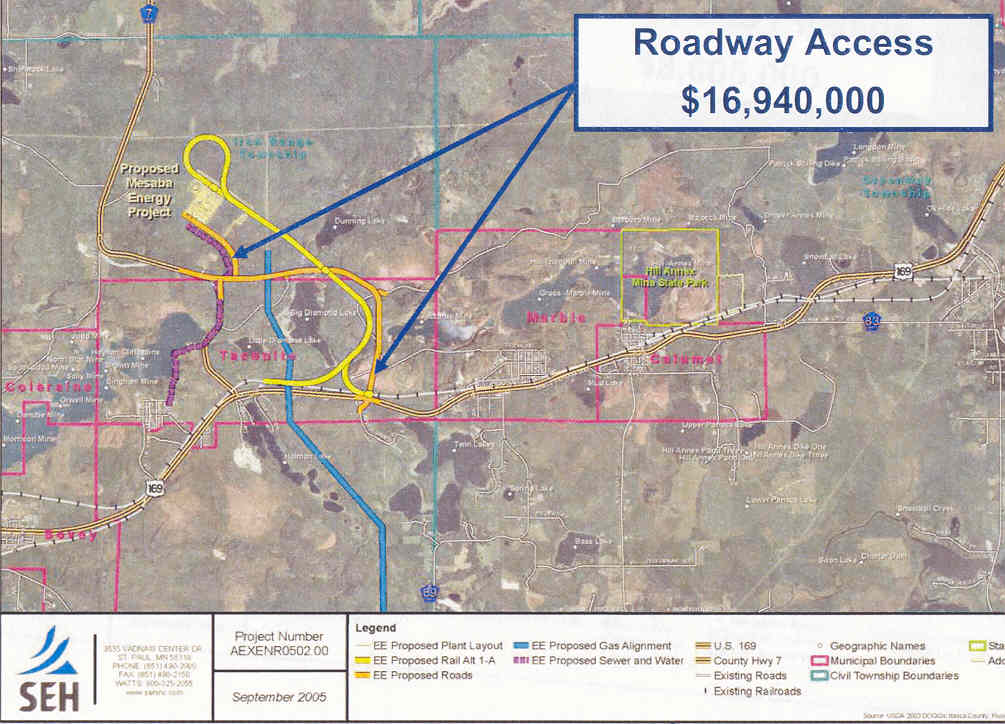
Can you see the place, the third line under “Legend” where it has that orange “road” and says “EE Proposed Route?” If you’re having trouble seeing it, here’s the full map on PDF: seh-ee-proposed-roads-public-infrastructure-improvement-study-jan-2006.pdf
Now what’s the purpose of this road? Whose brilliant idea was it? Who is paying for it? Who has the burden? Who has the risk? Who gets the benefit? Who is arranging for construction of this road, besides SEH, that is… and will someone please explain to me not only why that orange road is there in the first place, but why there’s that little orange spur going north? Itasca County Public Infrastructure… uh-huh… right… According to the legend, this is an “Excelsior Energy Proposed Road,” for access to the plant. Is Excelsior Energy paying for it? $16,940,000!
DUCK, CHUCK, IT’S A DUCK!!!
It’s all about shifting the burdens and risk. Xcel Energy argues in its brief (Reed, Direct Testimony at 2-3, 6, et seq.) that Excelsior Energy is attempting an unprecedented shift of burdens and risk off of Excelsior onto Xcel, calling it, “beyond industry norms,” and “fundamentally inconsistent with the public interest.”
QUACK, QUACK, QUACK…
mncoalgasplant.com, in its Statement of the Case, argues that Excelsior Energy is impermissibly and improperly shifting the risks and burdens to the public.
QUACK, QUACK, QUACK, QUACK, QUACK, QUACK…
They seem to have a problem with our characterization of what’s coming down, what we’re observing.. Well, OK, fine, let’s all take a close look at the Infrastructure costs and see…
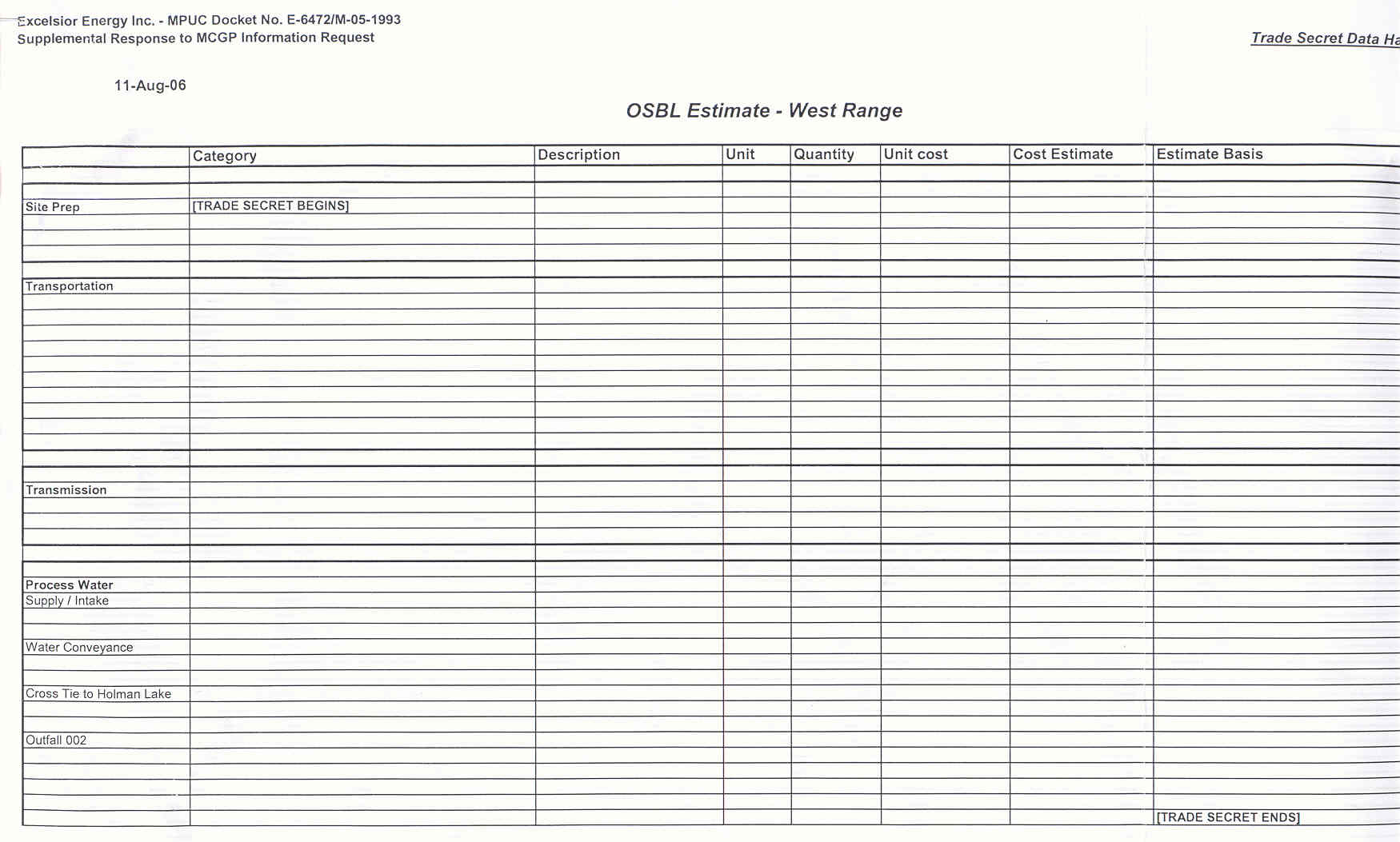
Ummmmmmm… there’s nothing there… well, let’s check out page 2:
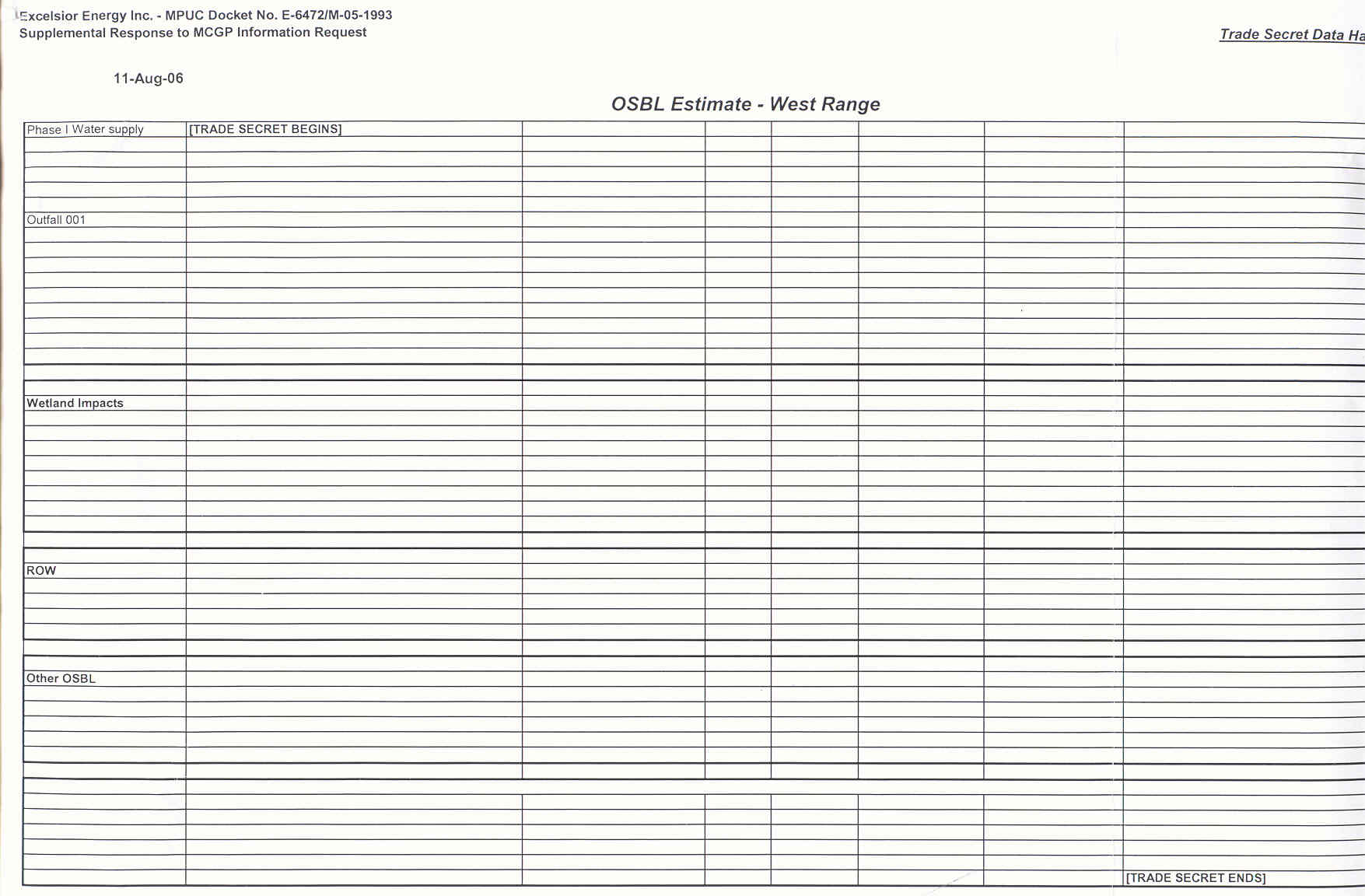
Yet Palast, Opponheim, and MacGregor wax on about U.S. utility regulatory process:
… In Britain, as in almost every country, prices are set in secret meetings between the government’s regulatory experts and utility executives. Under the guise of “commercial confidentiality,” the public is denied a view of all but a few bits of summary information. Public participation is limited to ineffective commentary on the small scraps of information not deemed confidential. The US system is the opposite.
For those who have never participated in a US price review, the documentation available is unimaginable. To justify its prices, a company typically files 300-3,000 pages of explanation, calculations and documentation. If requested by the regulator or by any customer, the utility company must provide all documents which back up its initial filing and answer in writing all questions relating to costs and operation (and provide documentation to back these). A typical price review can easily exceed 100,000 pages of information, all of it available for public inspection. In most cases, if requested by a customer orunion, the documents are copied at the company’s expense. By law, there are no secrets, no hidden documents. Crucially, the law bars regulators from issuing decisions on price or service unless every calculation and finding of fact is based on documentary evidence in the public record.
Democracy and Regulation: How the Public can Govern Essential Services, Palast, Oppenheim and MacGregor (2003). I guess they haven’t been to Minnesota. I guess they’ve not experienced what we are in the Excelsior/Mesaba case.
What we’re experienced is likely to change! We’ll be arguing about this secrecy on Thursday afternoon at the PUC, around 3 p.m. or so, in the large meeting room after the PUC Agenda Meeting about the Transmission Lines from Hell.
It’s all about burden shifting, it’s all about shifting the risk, shifting from those who have the most control over the outcome to those who have no control and who have the most to lose. It’s all right there, and the truth is coming out, slowly, we’re having to fight for every little scrap, but the pieces fit together and it’s beyond plausible denial. As Xcel’s Krikava is fond of saying, “It is what it is,” and as Xcel’s Don Jones testified, “If it’s all connected, it’s all connected.” Yes, it is all connected, we’re calling it as we see it.
You say “Po-tay-toe” … I say “Po-tot-oh”… let’s call the whole thing off…
Better yet, go tell it to the judge…
…eeeeeeuw, what was that I just stepped in… damn, it’s everywhere… and getting deeper… where’s that hearing at? When? Not soon enough…
QUACK, QUACK… IT’S A DUCK, CHUCK, DUCK, IT’S A DUCK!